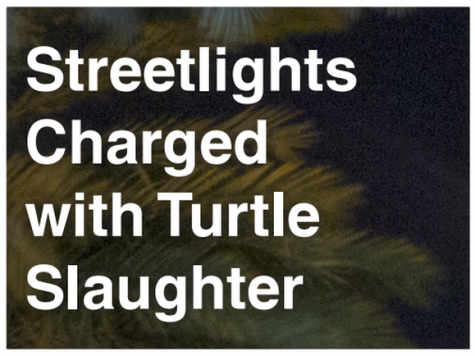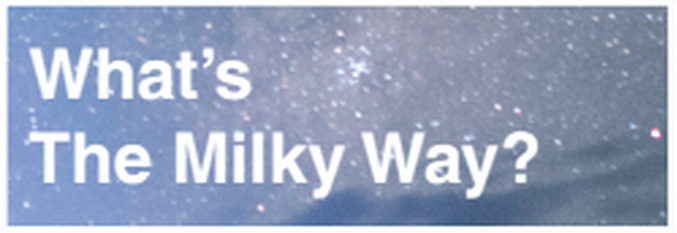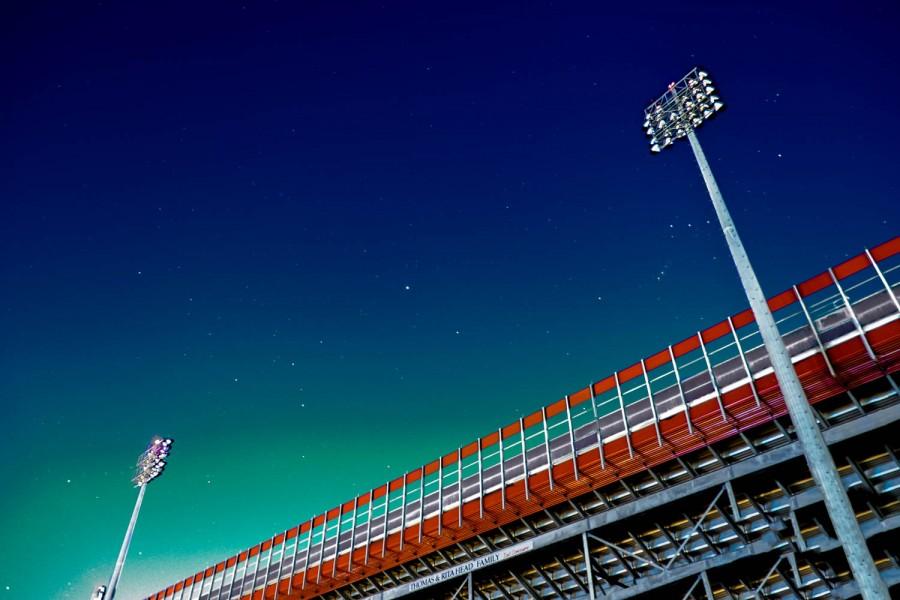Light pollution: Causing a mess of problems
Breast cancer, baby sea turtle deaths and angry astronomers all the world are all caused by too much wasteful light.
April 2, 2015
Looking up into the inky abyss above South Florida will not yield the sight that has inspired artists and scientists for centuries. Instead, the sight will be a few points of light struggling to be seen through the glow of neon signs, billboards, streetlights and spotlights, all of which contribute to worst pollutant mankind has ever made: artificial light.
Light pollution is excessive, wasteful man-made light. Not only did it waste money (it cost the United States $3.5 billion in 2012), but it is also a contributing cause of breast cancer. Light pollution also leads to hatching turtles on the beach to their death and hides space from us behind a curtain of pollution.

For millions of years, the Earth was not lit by artificial light at night, but by the stars and moon.
This constant cycle of light and dark has caused every above-ground creature’s biology — like trees, bats, and humans — to evolve with their biology depending on it. When we have bright flood lights at night, such as those at the football stadium, a monkey wrench is thrown into bodily systems all over Earth and something is bound to get
screwed up.
Breast cancer is one of these screwups. Cancer itself is when a cell begins dividing out of control and creates millions of copies of itself. This starts because of damage to the DNA in the cell, which dictates how it functions.
Our bodies know it is night when our eyes no longer see blue light — the sky. At this point, our bodies stop producing hormones and start fixing the DNA in our cells, reducing the chances of cell growth becoming rampant. This only happens at night. Eric Vandernoot, vice president of the South Florida chapter of the International Dark Sky Association and astronomy teacher at FAU, gives us a metaphor: “You don’t repair your car while you are driving down the highway.”
Flood lights are a large contributor to light pollution. Our football stadium lights are an on-campus example. According to Vandernoot, they raise the risk of breast cancer.
The Journal of Environmental Health Perspectives describes results from research on this subject: “Women who work night shifts have shown higher rates of breast cancer, whereas blind women, who are not likely to be exposed to or perceive [artificial lights at night], have shown decreased risks.”
We use light as judgement for our bodily clock, or our circadian rhythm. This controls certain bodily functions and when certain chemicals are released in our brains, such as the chemical that triggers cells to start repairing themselves. This rhythm, according to Vandernoot, can be interrupted by excessive displays of light, like those from the FAU stadium, which enter the dorms and can affect students’ sleep.

All along the beaches of Florida are sea turtle nests, where baby sea turtles are born into the light of streetlights, beach houses and cities. This is a problem for sea turtles who use the moonlight to guide their fledgling selves. They are an endangered species almost entirely because of this unnecessary light pouring onto the beaches.
“Hatchlings tend to move in the brightest direction, which on a naturally lit beach is the open view of the night sky over the sea. Light provides information. Artificial lighting can provide misinformation and can lead hatchlings astray. When this happens, hatchlings never make it to the sea and they commonly die,” according to Blair Witherington — a sea turtle researcher for Disney’s Animals, Science, and Environment, and the Archie Carr Center for Sea Turtle Research at the University of Florida.
“A best guess is that poorly used lights cause the deaths of over 100,000 sea turtle hatchlings each year in Florida. It is likely the number one cause of hatchling mortality during their movement from nest to sea,” adds Witherington.
In Boca Raton in 2001, there was an initiative by the Florida Department of Transportation to fix turtle hatchling problem by embedding lights in the road, and turning off streetlights during hatching season. An FAU study in 2001 found this to be successful, with a 98 percent reduction in the amount of straying hatchlings.
“Why we feel everything on the planet has to make way for us, I don’t know. We have to respect their right to live as well,” Vandernoot commented.
Vandernoot also describes how excessive lights at night are harming more than just endangered species in our own neighborhood.
Moths are genetically programmed to follow the light of the moon to guide themselves. When they see a streetlamp, they fly toward it and spend the night circling it, because they cannot fathom what it is and are not programmed to know what to do if they actually reach the light. This takes away from the week or two they have to breed, which leads to the decline of their population.
Just as blue light tells human bodies how to function, red light does the same for trees. Many trees around campus have lights shining upward toward them. The tree is practically frozen in one day in the season because the light keeps the tree from recognizing the change of its environment, hindering its growth and health.

In 1994 in Los Angeles, there occurred an event typical for California: an earthquake. What wasn’t typical is that it caused a major blackout, revealing the Milky Way for the first time to the Angelenos. Many of these people called the Griffith Observatory nearby to see this once-in-a-lifetime occurrence up close, while some called 911 asking about the strange silver cloud that suddenly appeared in the sky.
The light pollution in LA is so significant that people there had never seen more than a few stars; the Milky Way had turned into a myth. With “light pollution growing worldwide at about six percent per year exponentially … It’s estimated that kids born today will never see the Milky Way,” said Vandernoot.
Vandernoot, who has been teaching astronomy within FAU’s Astronomical Observatory since 2005, is one of many astronomers who have not been able to fully study and teach about the cosmos above because of the light from below.
According to him, there doesn’t even have to be an entire city to cause significant light pollution either; the football stadium lights here at FAU are enough to cause an issue.
“The stadium lights make very noticeable light pollution,” stated Vandernoot. Taking photos with the telescope has been a problem — most of his photos come out grey because of these lights. Using computer programs to edit out the light pollution left the photo noisy and blurry.
The frosting on the cake for light pollution is that the Environmental Protection Agency does not consider light a pollutant. This makes it even more difficult for astronomers and other scientists as well to fight for it to be more controlled. In a response to a letter from a science-oriented fraternity concerning light pollution, the EPA claims that, “based on the common understanding of ‘substance or matter,’ as illustrated by the dictionary definitions of these terms, [the] EPA has concluded that light is neither substance nor matter and, thus, does not clearly fall within the definition of ‘air pollutant.’”
Vandernoot did the math using Einstein’s famous equation, E=mc2 (where c is the speed of light and E is energy), to find what 25.4 billion kilowatt-hours of electricity that became light pollution in 2012 would be in mass. He found that a year’s worth of wasted light was about 1.4 kilograms — or about the same as a bottle and a half of wine, with Vandernoot claiming that it is the “most toxic pollutant we know about.” And also that “this wasted lighting energy is equivalent to over 968 million gallons of gasoline … being launched off into outer space per year.”
Vandernoot says that in one part of Isaac Newton’s writing, he said that the stars above were so bright he could see his shadow.







